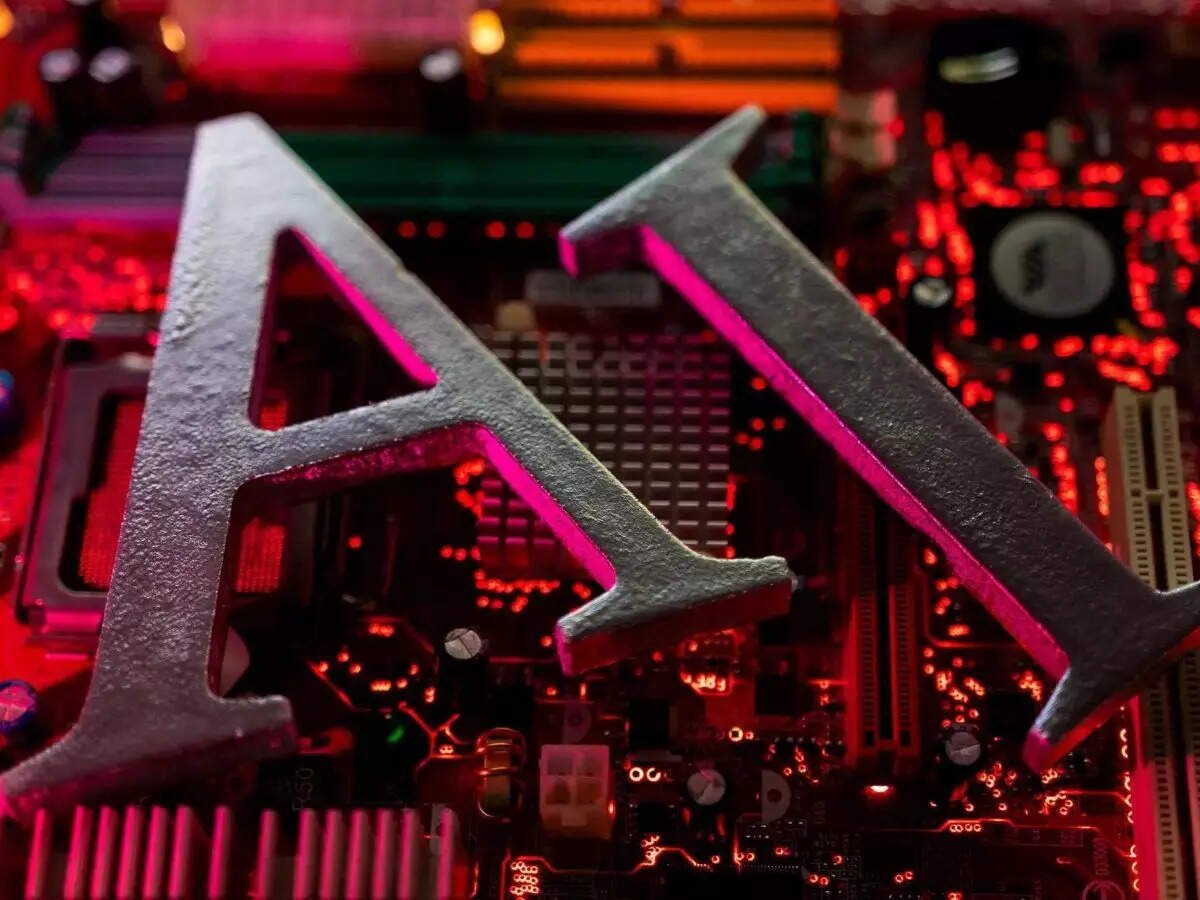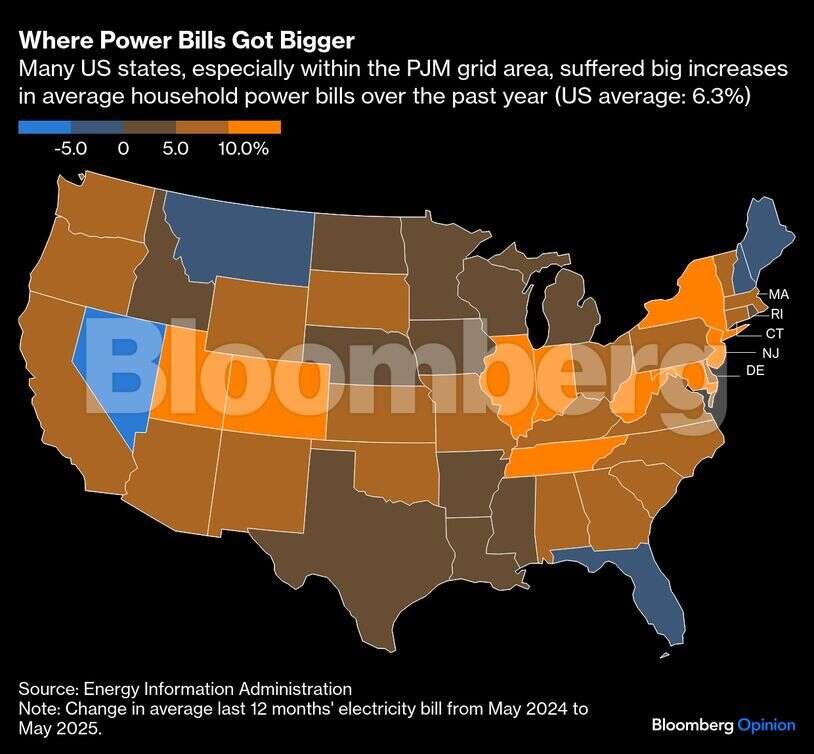AI Insights
AI Boom Drives Up Electricity Costs for Millions of Americans, ETTelecom

By Liam Denning
Silicon Valley, powerful as it is, should be wary of ticking off 67 million Americans.PJM Interconnection is a regional transmission organization that manages the biggest electricity grid in the US, covering all or part of 13 Midwestern and mid-Atlantic states plus the District of Columbia. In all but four of those states, plus DC, average annual power bills in the year through May increased faster than the national average, which was eyewatering in itself at over 6%.
Plug prices, rather than pump prices, are igniting a political firestorm. In New Jersey, the latest flashpoint, utility bills figure prominently in a gubernatorial race that has gained national attention and is less than three months from election day. And at the heart of all this is the race for artificial intelligence.

New Jersey residents, whose 13.3% bill increase was the third-highest in the US, can perhaps draw some comfort from New York faring worse, where bills surged 14.4%. More pertinently, 94% of the increase in PJM wholesale power prices — which cover generation and transmission but not distribution charges — through May related to the energy component according to Monitoring Analytics, the grid’s independent market monitor. That element, mostly related to natural gas prices, should level off or even decline.
Now for the bad news: These residential billing data only run through May. That was just before the impact of a monumental jump in capacity prices, based on an auction run by PJM last year, kicked in. This chart of more up-to-date wholesale prices shows further pain is coming.

Capacity auctions set payments to generators that encourage them to keep existing plants open or build new ones, separate from the revenue they earn for actually producing electricity. This is a crucial, if arcane, corner of the power market and its shock will stick because it gets set for a year at a time — and the latest auction, for the year beginning June 2026, came in even higher.After many years of flat electricity demand, PJM now forecasts an imminent jump, and it takes time — as well as spiking price signals — for energy supply to react. The culprit is the AI boom, with PJM serving Virginia’s burgeoning data center alley. Some 64% of those ballooning capacity payments that began hitting bills in June relate to actual and projected datacenter demand, according to Monitoring Analytics’ calculations.

The latest auction, high as it was, was actually capped after Pennsylvania Governor Josh Shapiro complained. But price caps merely relieve symptoms and do nothing for the underlying condition.The auction itself needs fixing. Hugh Wynne, utilities analyst at Sector and Sovereign Research LLC, compares it to a “rain dance” that doesn’t deliver what it is supposed to: New capacity. The inflated costs of the last two auctions are enough, by his calculation, to fund 19 gigawatts of new gas-fired capacity, yet cleared only four gigawatts of actual new additions. The result is a transfer of a wealth from homeowners mostly to existing generators for little reward.
Part of the problem is timing. Auctions are supposed to set prices several years out but delays have shortened that period to less than 12 months, completely inadequate for planning plants that take years to construct. In addition, PJM has adopted more conservative assumptions for the reliability of different types of generation. While these are shaped by the poor performance of plants during prior extreme weather events, they effectively reduce the total capacity assumed to be available, thereby driving up the auction price, and may be worth revisiting given lessons learned from those episodes.
PJM has implemented or proposed several reforms, such as expanding participation by certain types of generation. Wynne suggests splitting the capacity market into one for existing plants and another for new capacity, thereby offering more surety of pricing for the latter and, presumably, less of a windfall for the former.
Lawmakers are proposing more radical, and heavy handed, measures. Pennsylvania’s legislature is considering bills that would allow regulated utilities, which own the wires, to also invest in new power plants that would compete with independent generators. Meanwhile, New Jersey’s general assembly passed a bill directing regulators to explore alternatives including withdrawing from the capacity auction or even PJM altogether. Although it is not uncommon for politicians to lose faith in competitive energy markets at moments of stress (see California in 2002), “to unwind that clock would take a long time, likely be expensive and be fraught with uncertainty,” warns Timothy Fox, who leads power sector research for ClearView Energy Partners, a Washington-based analysis firm.
It would be absurd to abandon the benefits of decades of deregulation just to accommodate data centers; rather, the onus is largely on them. At a minimum, they should be required to effectively bring their own power, committing to long-term power purchase agreements to support new plants, not just signing contracts for existing capacity. That new capacity would increase the grid’s resilience overall, shifting datacenters from being a challenge to being part of the solution. In return, such plants could be given priority in terms of permitting and interconnection.
Training and using these models is more energy intensive than conventional internet browsing, particularly if the sort of always-on AI agent envisioned by OpenAI’s Sam Altman becomes common. Yet datacenter operators have an economic incentive to become more efficient and the tools to do so. Along with bringing new hardware to the grid in the form of generating capacity, AI giants could presumably also deploy software to use that grid in smarter ways, such as those advanced by Vijay Gadepally at MIT’s Lincoln Laboratory. To a large extent, if AI is all it’s cracked up to be, it should be an energy problem that ultimately solves itself. Indeed, the building backlash in PJM indicates it must.
AI Insights
Artificial intelligence offering political practices advice about robocalls in Montana GOP internal spat

A version of this story first appeared in Capitolized, a weekly newsletter featuring expert reporting, analysis and insight from the editors and reporters of Montana Free Press. Want to see Capitolized in your inbox every Thursday? Sign up here.
The robocalls to John Sivlan’s phone this summer just wouldn’t let up. Recorded messages were coming in several times a day from multiple phone numbers, all trashing state Republican Rep. Llew Jones, a shrewd, 11-term lawmaker with an earned reputation for skirting party hardliners to pass the Legislature’s biggest financial bills, including the state budget.
Sivlan, 80, a lifelong Republican who lives in Jones’ northcentral Montana hometown of Conrad, wasn’t amused by the general election-style attacks hitting his phone nearly a year before the next legislative primary. Jones, in turn, wasn’t impressed with the Commissioner of Political Practices’ advice that nothing could be done about the calls. The COPP polices campaigns and lobbying in Montana, and the opinion the office issued in response to a request from Jones to review the robocalls was written not by an office employee but instead authored by ChatGPT.
“They were coming in hot and heavy in July,” Sivlan said on Aug. 26 while scrolling through his messages. “There must be dozens of these.”
“Did you know that Llew Jones sides with Democrats more than any other Republican in the Montana Legislature? If he wants to vote with Democrats, Jones should at least switch parties,” the robocalls said.
“And then they list his number and tell you to call him and tell him,” Sivlan continued.
In addition to the robocalls, a string of ads running on streaming services targeted Jones. On social media, placement ads depicted Jones as the portly, white-suited county commissioner Boss Hogg from “The Dukes of Hazzard” TV comedy of the early 1980s. None of the ads or calls disclosed who was paying for them.
Jones told Capitolized that voters were annoyed by the messaging, but said most people he’s talked to weren’t buying into it. He assumes the barrage was timed to reach voters before his own campaign outreach for the June 2026 primary.
The COPP’s new AI helper concluded that only ads appearing within 60 days of an election could be regulated by the office. The ads would also have to expressly advise the public on how to vote to fall under campaign finance reporting requirements.
In the response emailed to Jones, the AI program followed its opinion with a very chipper “Would you like guidance on how to monitor or respond to such ads effectively?”
“I felt that it was OK,” Commissioner Chris Gallus said of the AI opinion provided to Jones. “There were some things that I probably would have been more thorough about. Really at this point I wanted Llew to see where we were at that time with the (AI) build-out, more than explicit instructions.”
The plan is to prepare the COPP’s AI system for the coming 2026 primary elections, at which point members of the COPP staff will review the bot’s responses and supplement when necessary. But the system is already on the commissioner’s website, offering advice based solely on Montana laws and COPP’s own data, and not on what it might scrounge from the internet, according to Gallus.
Earlier this year, the Legislature put limits on AI use by government agencies, including a requirement for government disclosure and oversight of decisions and recommendations made by AI systems. The bill, by Rep. Braxton Mitchell, R-Columbia Falls, was opposed by only a handful of lawmakers.
Gallus said the artificial intelligence system at COPP is being built by 3M Data, a vendor with previous experience with machine learning for the Red Cross and the oil companies Shell and Exxon, where systems gathered and analyzed copious amounts of operational data. COPP has about $38,000 to work with, Gallus said.
The pre-primary battles within the Montana Republican Party are giving the COPP’s machine learning an early test, while also exposing loopholes in campaign reporting laws.
There is no disclosure law for the ads placed on streaming services, unlike ad details for traditional radio and TV stations, cable and satellite, which must be available for public inspection under Federal Communications Commission law. The state would have to fill that gap, which the FCC and Federal Election Commission have struggled to do since 2011.
Streaming now accounts for 45% of all TV viewing, according to Nielsen, more than broadcast and cable combined. Cable viewership has declined 39% since 2021.
“When we asked KSEN (a popular local radio station) who was paying for the ads, they didn’t know,” Jones said. “People were listening on Alexa.”
Nonetheless, Jones said the robocalls are coming from within the Republican house. An effort by hardliners to purge more centrists legislators from the party has been underway since April, when the MTGOP executive board began “rescinding recognition” of the state Republican senators who collaborated with a bipartisan group of Democrats and House Republicans to pass a budget, increase teacher pay and lower taxes on primary homes.
Being Republican doesn’t require recognition by the MTGOP “e-board,” as it’s known. In June, when the party chose new leadership, newly elected Chair Art Wittich said the party would no longer stay neutral in primary elections and would look for conservative candidates to support.
Republicans who have registered campaigns for the Legislature were issued questionnaires Aug. 17 by the Conservative Governance Committee, a group chaired by Keith Regier, a former state legislator and father of a Flathead County family that’s sent three members to the Montana Legislature; in 2023 Keith Regier and two of his children served in the Legislature simultaneously.
Membership for the Conservative Governance Committee and a new Red Policy Committee to prioritize legislative priorities is still a work in progress, new party spokesman Ethan Holmes said this week.
The 14 questions, which Regier informed candidates could be used to determine party support of campaigns, hit on standard Republican fare: guns, “thoughts on transgenderism,” and at what point human life starts. There was no question about a willingness to follow caucus leadership. Regier’s son, Matt, was elected Senate president late 2024, but lost control of his caucus on the first day of the legislative session in January.
AI Insights
“AI Is Not Intelligent at All” – Expert Warns of Worldwide Threat to Human Dignity

Opaque AI systems risk undermining human rights and dignity. Global cooperation is needed to ensure protection.
The rise of artificial intelligence (AI) has changed how people interact, but it also poses a global risk to human dignity, according to new research from Charles Darwin University (CDU).
Lead author Dr. Maria Randazzo, from CDU’s School of Law, explained that AI is rapidly reshaping Western legal and ethical systems, yet this transformation is eroding democratic principles and reinforcing existing social inequalities.
She noted that current regulatory frameworks often overlook basic human rights and freedoms, including privacy, protection from discrimination, individual autonomy, and intellectual property. This shortfall is largely due to the opaque nature of many algorithmic models, which makes their operations difficult to trace.
The black box problem
Dr. Randazzo described this lack of transparency as the “black box problem,” noting that the decisions produced by deep-learning and machine-learning systems cannot be traced by humans. This opacity makes it challenging for individuals to understand whether and how an AI model has infringed on their rights or dignity, and it prevents them from effectively pursuing justice when such violations occur.

“This is a very significant issue that is only going to get worse without adequate regulation,” Dr. Randazzo said.
“AI is not intelligent in any human sense at all. It is a triumph in engineering, not in cognitive behaviour.
“It has no clue what it’s doing or why – there’s no thought process as a human would understand it, just pattern recognition stripped of embodiment, memory, empathy, or wisdom.”
Global approaches to AI governance
Currently, the world’s three dominant digital powers – the United States, China, and the European Union – are taking markedly different approaches to AI, leaning on market-centric, state-centric, and human-centric models, respectively.
Dr. Randazzo said the EU’s human-centric approach is the preferred path to protect human dignity, but without a global commitment to this goal, even that approach falls short.
“Globally, if we don’t anchor AI development to what makes us human – our capacity to choose, to feel, to reason with care, to empathy and compassion – we risk creating systems that devalue and flatten humanity into data points, rather than improve the human condition,” she said.
“Humankind must not be treated as a means to an end.”
Reference: “Human dignity in the age of Artificial Intelligence: an overview of legal issues and regulatory regimes” by Maria Salvatrice Randazzo and Guzyal Hill, 23 April 2025, Australian Journal of Human Rights.
DOI: 10.1080/1323238X.2025.2483822
The paper is the first in a trilogy Dr. Randazzo will produce on the topic.
Never miss a breakthrough: Join the SciTechDaily newsletter.
AI Insights
Mexico says works created by AI cannot be granted copyright
In an era where artwork is increasingly influenced and even created by Artificial Intelligence (AI), Mexico’s Supreme Court (SCJN) has ruled that works generated exclusively by AI cannot be registered under the copyright regime. According to the ruling, authorship belongs solely to humans.
“This resolution establishes a legal precedent regarding AI and intellectual property in Mexico,” the Copyright National Institute (INDAUTOR) said on Aug. 28 in a statement on its official X account following the SCJN’s decision.
The SCJN’s unanimous decision said that the Federal Copyright Law (LFDA) reserves authorship to humans, and that any creative invention generated exclusively by algorithms lacks a human author to whom moral rights can be attributed.
According to the Supreme Court, automated systems do not possess the necessary qualities of creativity, originality and individuality that are considered human attributes for authorship.
“The SCJN resolved that copyright is a human right exclusive to humans derived from their creativity, intellect, feelings and experiences,” it said.
The Supreme Court resolved that works generated autonomously by artificial intelligence do not meet the originality requirements of the LFDA. It said that those requirements are constitutional as limiting authorship to humans is “objective, reasonable and compatible with international treaties.”
It further added that protections to AI can’t be granted on the same basis as humans, since both have intrinsically different characteristics.
What was the case about?
In August 2024, INDAUTOR denied the registration application for “Virtual Avatar: Gerald García Báez,” created with an AI dubbed Leonardo, on the basis that it lacked human intervention.
“The registration was denied on the grounds that the Federal Copyright Law (LFDA) requires that works be of human creation, with the characteristic of originality as an expression of the author’s individuality and personality,” INDAUTOR said.
The applicant contested the denial, arguing that creativity should not be restricted to humans. In the opinion of the defendant, excluding works generated by AI violated the principles of equality, human rights and international treaties, including the United States, Mexico and Canada agreement (USMCA) and the Berne Convention.
However, the Supreme Court clarified that such international treaties do not oblige Mexico to give copyrights to non-human entities or to extend the concept of authorship beyond what is established in the LFDA.
Does the resolution allow registration of works generated with AI?
Yes, provided there is a substantive and demonstrable human contribution. This means that works created in collaboration with AI, in which humans direct, select, edit or transform the result generated by AI until it is endowed with originality and a personal touch, are subject to registration before INDAUTOR.
Intellectual property specialists consulted by the newspaper El Economista explained that to register creative work developed in collaboration with AI, it is important to document the human intervention and submit the creative process in a way that aligns with the LFDA.
Mexico News Daily
-

 Business3 days ago
Business3 days agoThe Guardian view on Trump and the Fed: independence is no substitute for accountability | Editorial
-
Tools & Platforms3 weeks ago
Building Trust in Military AI Starts with Opening the Black Box – War on the Rocks
-

 Ethics & Policy1 month ago
Ethics & Policy1 month agoSDAIA Supports Saudi Arabia’s Leadership in Shaping Global AI Ethics, Policy, and Research – وكالة الأنباء السعودية
-

 Events & Conferences3 months ago
Events & Conferences3 months agoJourney to 1000 models: Scaling Instagram’s recommendation system
-

 Jobs & Careers2 months ago
Jobs & Careers2 months agoMumbai-based Perplexity Alternative Has 60k+ Users Without Funding
-

 Funding & Business2 months ago
Funding & Business2 months agoKayak and Expedia race to build AI travel agents that turn social posts into itineraries
-

 Education2 months ago
Education2 months agoVEX Robotics launches AI-powered classroom robotics system
-

 Podcasts & Talks2 months ago
Podcasts & Talks2 months agoHappy 4th of July! 🎆 Made with Veo 3 in Gemini
-

 Podcasts & Talks2 months ago
Podcasts & Talks2 months agoOpenAI 🤝 @teamganassi
-

 Mergers & Acquisitions2 months ago
Mergers & Acquisitions2 months agoDonald Trump suggests US government review subsidies to Elon Musk’s companies


















